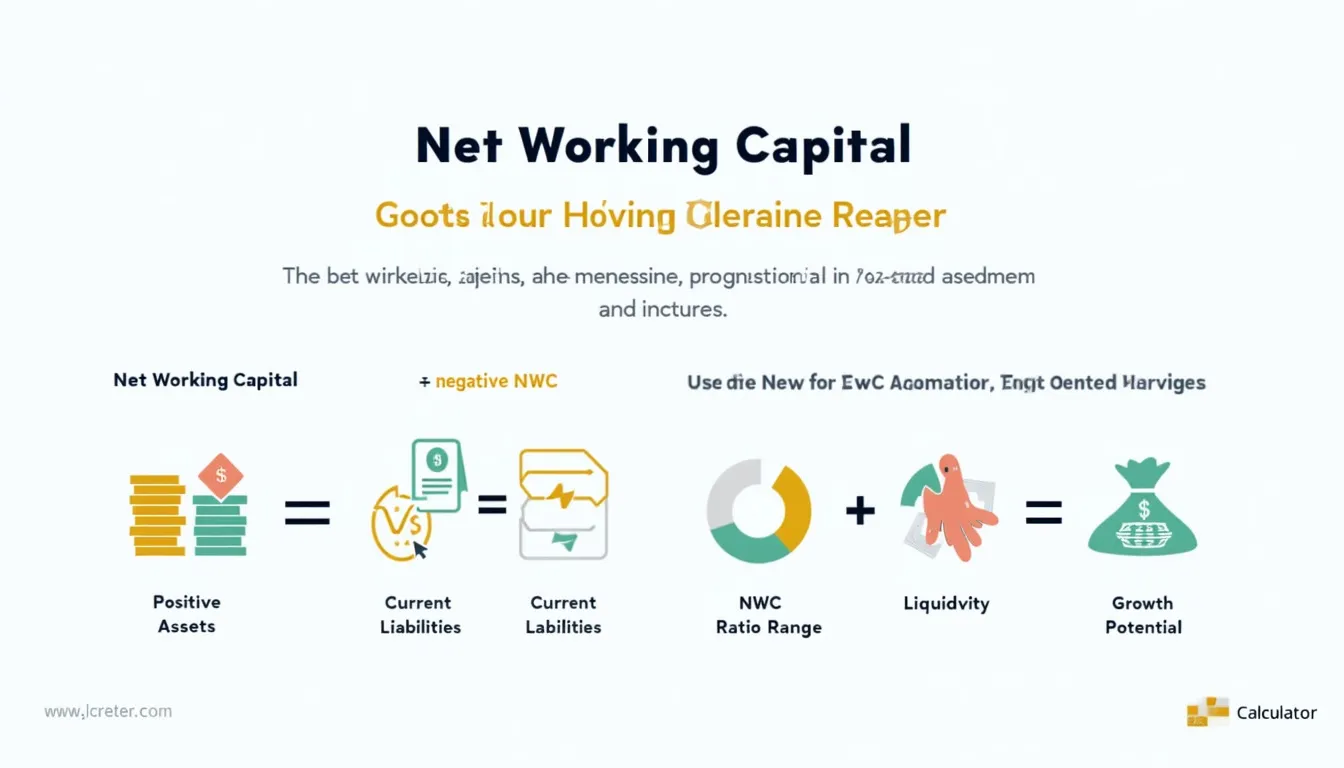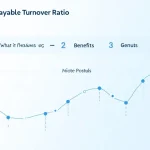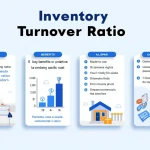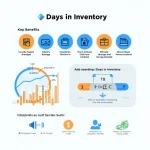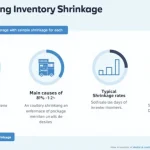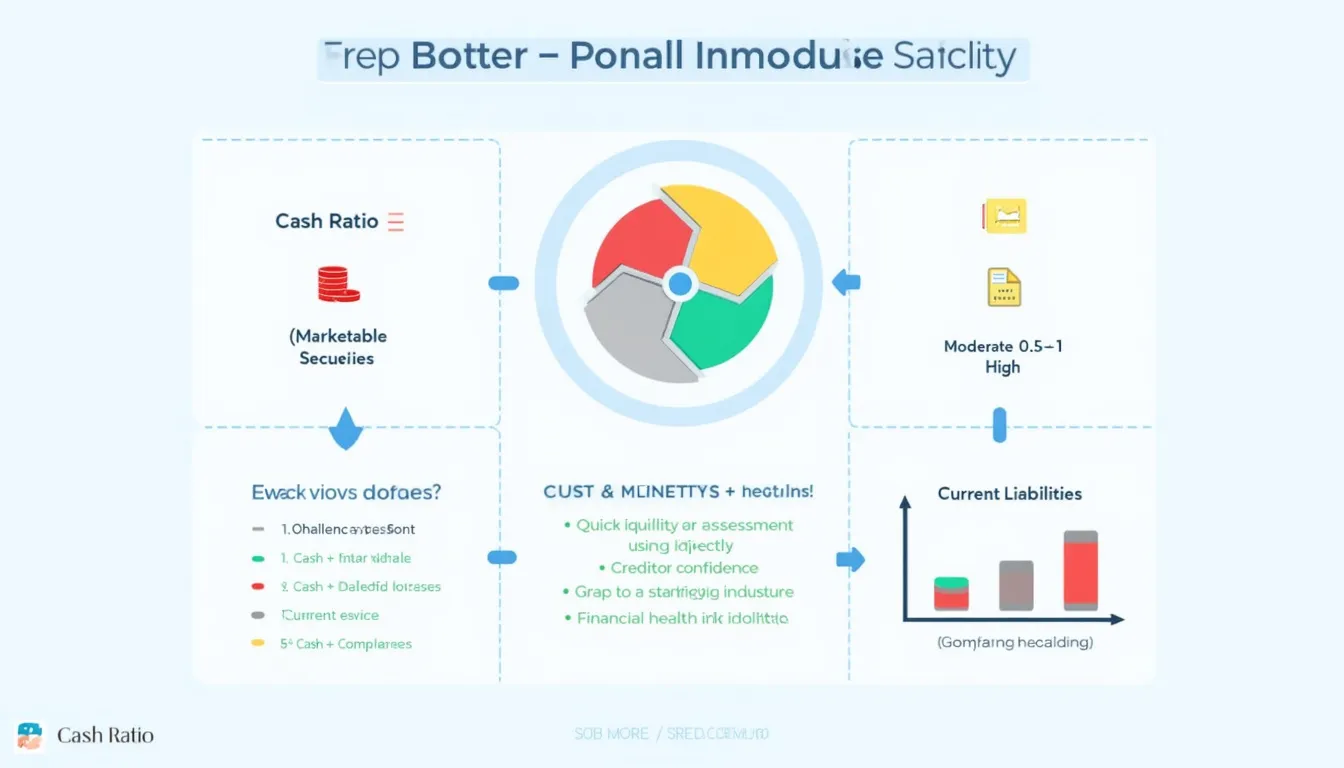Net Working Capital Calculator
Is this tool helpful?
How to Use the Net Working Capital Calculator Effectively
Our Net Working Capital Calculator is a powerful tool designed to help businesses assess their short-term financial health quickly and accurately. Here’s a step-by-step guide on how to use this calculator effectively:
- Gather financial data: Collect your company’s current financial statements, including the balance sheet.
- Identify current assets: Sum up all your company’s current assets, including cash, accounts receivable, inventory, and short-term investments.
- Calculate current liabilities: Add up all your company’s current liabilities, such as accounts payable, short-term debt, and accrued expenses.
- Enter the data: Input the total current assets and current liabilities into the respective fields in the calculator.
- Click “Calculate”: The tool will instantly compute your net working capital.
- Analyze the result: Interpret the calculated figure to understand your company’s liquidity position.
By following these steps, you can quickly obtain an accurate assessment of your company’s net working capital, enabling you to make informed financial decisions.
Understanding Net Working Capital: Definition, Purpose, and Benefits
Net Working Capital (NWC) is a crucial financial metric that measures a company’s short-term financial health and operational efficiency. It is calculated by subtracting current liabilities from current assets, represented by the formula:
$$\text{Net Working Capital} = \text{Current Assets} – \text{Current Liabilities}$$
The primary purpose of calculating net working capital is to assess a company’s liquidity and ability to meet its short-term obligations. A positive NWC indicates that a company has sufficient liquid assets to cover its immediate liabilities, while a negative NWC suggests potential liquidity issues.
Key benefits of understanding and monitoring your net working capital include:
- Assessing short-term financial stability
- Identifying potential cash flow problems
- Evaluating operational efficiency
- Supporting informed decision-making
- Facilitating better financial planning
The Importance of Net Working Capital in Business Finance
Net working capital plays a crucial role in various aspects of business finance:
1. Liquidity Management
NWC is a key indicator of a company’s liquidity position. A healthy NWC ensures that a business can meet its short-term obligations without resorting to external financing or selling long-term assets.
2. Operational Efficiency
By monitoring NWC, businesses can identify areas for improvement in their operational efficiency. For example, a consistently high NWC might indicate excess inventory or inefficient cash management.
3. Growth Potential
A positive and growing NWC can signal a company’s ability to fund expansion or new projects without relying heavily on external financing.
4. Financial Health Indicator
Investors and creditors often use NWC as a measure of a company’s financial health and ability to weather economic downturns.
5. Cash Flow Management
NWC is closely tied to cash flow management. By optimizing NWC, businesses can improve their cash flow and reduce the need for short-term borrowing.
Benefits of Using the Net Working Capital Calculator
Our Net Working Capital Calculator offers numerous advantages for businesses of all sizes:
1. Time-Saving Efficiency
The calculator eliminates the need for manual calculations, saving valuable time for business owners and financial managers.
2. Accuracy and Reliability
By automating the calculation process, the tool minimizes the risk of human error, ensuring accurate results every time.
3. Real-Time Financial Insights
Users can quickly obtain up-to-date information about their company’s liquidity position, enabling timely decision-making.
4. Scenario Planning
The calculator allows for easy manipulation of input values, facilitating “what-if” analyses and scenario planning.
5. Accessibility and Convenience
Available online, the calculator can be accessed anytime, anywhere, making it a convenient tool for busy professionals.
6. Educational Value
For those new to financial analysis, the calculator serves as an educational tool, helping users understand the relationship between assets, liabilities, and working capital.
Addressing User Needs and Solving Specific Problems
The Net Working Capital Calculator addresses several key user needs and solves specific problems faced by businesses:
1. Quick Financial Health Check
For businesses needing a rapid assessment of their short-term financial position, the calculator provides instant results, allowing for quick decision-making.
2. Identifying Liquidity Issues
By clearly displaying the net working capital figure, the calculator helps businesses identify potential liquidity problems before they become critical.
3. Facilitating Financial Planning
The tool enables businesses to project future working capital needs by adjusting input values, supporting more effective financial planning.
4. Improving Investor Communication
With accurate NWC figures readily available, businesses can more effectively communicate their financial position to investors and stakeholders.
5. Benchmarking Performance
By regularly calculating NWC, businesses can track their financial performance over time and benchmark against industry standards.
Practical Applications and Use Cases
The Net Working Capital Calculator has numerous practical applications across various business scenarios:
1. Seasonal Business Planning
A retail business can use the calculator to assess its working capital needs during peak seasons, ensuring sufficient liquidity to manage increased inventory and operational costs.
2. Merger and Acquisition Analysis
During M&A due diligence, the calculator can quickly provide insights into a target company’s short-term financial health.
3. Loan Application Preparation
When applying for a business loan, companies can use the calculator to demonstrate their liquidity position to potential lenders.
4. Supply Chain Management
Manufacturers can utilize the tool to optimize their working capital by balancing inventory levels with accounts payable and receivable.
5. Start-up Cash Flow Management
New businesses can leverage the calculator to project and manage their working capital needs during the critical early stages of operation.
Frequently Asked Questions (FAQ)
1. What is considered a good net working capital?
A positive net working capital is generally considered good, as it indicates that a company can cover its short-term liabilities with its current assets. However, the ideal NWC varies by industry and company size. Generally, a ratio of current assets to current liabilities between 1.2 and 2.0 is considered healthy.
2. Can net working capital be negative?
Yes, net working capital can be negative when current liabilities exceed current assets. This situation may indicate potential liquidity issues and should prompt a closer examination of the company’s financial position.
3. How often should I calculate my company’s net working capital?
It’s advisable to calculate net working capital at least quarterly, aligning with financial reporting periods. However, for businesses with rapid cash flow changes, more frequent calculations may be beneficial.
4. How does net working capital differ from working capital?
While often used interchangeably, there is a subtle difference. Working capital refers to a company’s current assets, while net working capital is the difference between current assets and current liabilities.
5. Can I improve my net working capital?
Yes, you can improve your net working capital by:
- Improving inventory management
- Accelerating accounts receivable collection
- Negotiating better terms with suppliers
- Optimizing cash management
- Reducing unnecessary expenses
6. Is a high net working capital always better?
Not necessarily. While a positive NWC is generally good, an excessively high NWC might indicate that a company is not efficiently using its resources. It could suggest overstocking of inventory or poor management of accounts receivable.
7. How does net working capital impact business valuation?
Net working capital is an important factor in business valuation. A healthy NWC can increase a company’s value by demonstrating strong liquidity and operational efficiency. Conversely, a negative or declining NWC might negatively impact valuation.
8. Can the Net Working Capital Calculator be used for personal finance?
While primarily designed for businesses, the concept can be applied to personal finance. Individuals can use it to assess their short-term financial health by comparing liquid assets to short-term obligations.
9. How accurate is the Net Working Capital Calculator?
The calculator provides accurate results based on the input data. However, the accuracy of the output depends on the accuracy and completeness of the financial data entered.
10. Are there limitations to using net working capital as a financial metric?
Yes, while NWC is a useful metric, it should not be used in isolation. It doesn’t provide information about the quality of assets or the specific nature of liabilities. Additionally, it’s a snapshot in time and may not reflect ongoing changes in a company’s financial position.
Please note that while our Net Working Capital Calculator is designed to provide accurate results, we cannot guarantee that the webtool or results from our webtool are always correct, complete, or reliable. Our content and tools might have mistakes, biases, or inconsistencies. It’s always advisable to consult with a financial professional for important financial decisions.
Conclusion: Empowering Financial Decision-Making with the Net Working Capital Calculator
The Net Working Capital Calculator is an invaluable tool for businesses seeking to optimize their financial health and make informed decisions. By providing quick, accurate assessments of a company’s short-term liquidity position, this calculator empowers users to:
- Gain real-time insights into their financial stability
- Identify potential liquidity issues before they become critical
- Make data-driven decisions about cash flow management
- Plan effectively for future financial needs
- Communicate more effectively with stakeholders about the company’s financial position
In today’s fast-paced business environment, having access to accurate financial information is crucial. Our Net Working Capital Calculator streamlines this process, making it easier than ever to stay on top of your company’s financial health.
We encourage you to make the Net Working Capital Calculator a regular part of your financial analysis toolkit. By doing so, you’ll be better equipped to navigate the complexities of business finance, optimize your working capital, and drive your company towards sustainable growth and success.
Take control of your company’s financial future today – use our Net Working Capital Calculator and unlock the power of informed financial decision-making!
Important Disclaimer
The calculations, results, and content provided by our tools are not guaranteed to be accurate, complete, or reliable. Users are responsible for verifying and interpreting the results. Our content and tools may contain errors, biases, or inconsistencies. We reserve the right to save inputs and outputs from our tools for the purposes of error debugging, bias identification, and performance improvement. External companies providing AI models used in our tools may also save and process data in accordance with their own policies. By using our tools, you consent to this data collection and processing. We reserve the right to limit the usage of our tools based on current usability factors. By using our tools, you acknowledge that you have read, understood, and agreed to this disclaimer. You accept the inherent risks and limitations associated with the use of our tools and services.
